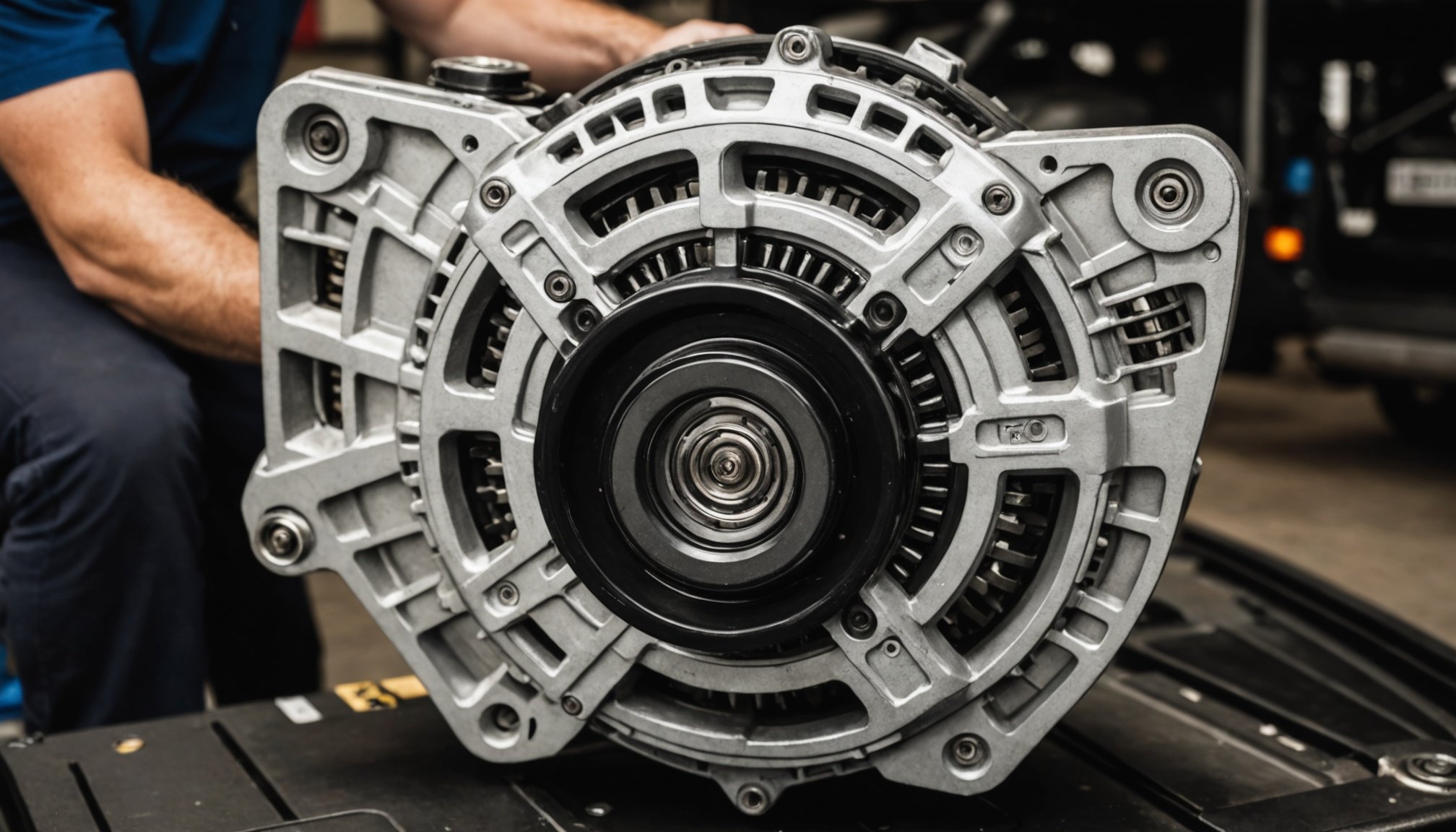Ultimate Guide to Replacing Your Land Rover Discovery’s Alternator for Peak Performance
Understanding the Importance of Your Alternator
When it comes to maintaining your Land Rover Discovery, one of the most critical components to focus on is the alternator. This vital part of your vehicle’s electrical system is responsible for charging your battery and powering the various electrical systems, from the headlights to the infotainment system. A failing alternator can lead to a range of issues, including a dead battery, dimming lights, and even engine stalling.
“Ensuring your alternator is in top condition is crucial for the overall health of your vehicle,” says John Smith, a seasoned Land Rover mechanic. “It’s not just about keeping your lights on; it’s about maintaining the integrity of your entire electrical system.”
Additional reading : Enhance your toyota celica”s brake performance: the ultimate guide to upgrading front calipers for superior stopping power
Identifying Signs of a Failing Alternator
Before you embark on the replacement process, it’s essential to identify the signs that indicate your alternator is failing. Here are some key indicators:
- Dim or Flickering Lights: If your headlights or interior lights are dimming or flickering, it could be a sign that your alternator is not producing enough voltage.
- Dead Battery: If your battery is frequently dead, even after jump-starting, it might be due to a malfunctioning alternator.
- Unusual Noises: A whining or grinding noise coming from the alternator area can indicate worn-out bearings or other internal issues.
- Electrical System Malfunctions: If your car’s electrical systems, such as the radio or wipers, are not functioning properly, it could be related to a failing alternator.
Preparing for the Replacement
Replacing the alternator in your Land Rover Discovery is a manageable task, but it requires some preparation and the right tools. Here’s what you need to do:
Have you seen this : Transform your bmw 3 series: the comprehensive guide to installing adaptive headlights for superior night vision
Gather Necessary Tools and Parts
- New Alternator: Ensure you purchase a compatible alternator for your specific Land Rover Discovery model. For example, the LR3 alternator (YLE500410) is specific to V6 engines[4].
- Socket Set: You’ll need a socket set to remove the alternator belt and other components.
- Torx Screwdriver: Depending on the model, you might need a Torx screwdriver for certain bolts.
- Wrenches: Adjustable wrenches and pliers can be handy for loosening belts and hoses.
Consult Your Manual
- Always refer to your Land Rover Discovery’s service manual for specific instructions and diagrams. This will help you understand the layout and any model-specific steps.
Step-by-Step Guide to Replacing the Alternator
Disconnect the Battery
Before starting any electrical work, ensure your safety by disconnecting the battery. This prevents any accidental starts or electrical shocks.
Remove the Alternator Belt
- Locate the serpentine belt that drives the alternator. You can refer to a serpentine belt routing diagram specific to your model, such as the one for the Discovery Series II[2].
- Use a socket to loosen the belt tensioner and remove the belt from the alternator pulley.
Disconnect Electrical Connections
- Identify the electrical connections to the alternator. These usually include the battery cable and any other wiring harnesses.
- Use a wrench or pliers to loosen the nuts holding these connections in place, then pull them off.
Remove Mounting Bolts
- Locate the mounting bolts that hold the alternator in place. These are typically found on the engine block or a bracket.
- Use a socket to remove these bolts, then gently pull the alternator out of its mounting position.
Install the New Alternator
- Place the new alternator in its mounting position and secure it with the mounting bolts.
- Ensure all connections are tight but do not overtighten.
Reconnect Electrical Connections
- Reattach the electrical connections to the new alternator. Make sure they are securely fastened.
- Double-check that all connections are correct and not loose.
Reinstall the Alternator Belt
- Place the serpentine belt back onto the alternator pulley.
- Tighten the belt tensioner to the recommended specification.
Reconnect the Battery
- Once all connections are made, reconnect the battery.
Post-Installation Checks
After replacing the alternator, it’s crucial to perform some checks to ensure everything is working correctly:
Battery Voltage Check
- Use a multimeter to check the battery voltage. It should read around 13.5-14.5 volts when the engine is running.
- If the voltage is lower, it may indicate an issue with the new alternator or the electrical system.
Electrical System Test
- Turn on various electrical systems like the headlights, radio, and wipers to ensure they are functioning properly.
Maintenance Tips to Extend Alternator Life
To ensure your new alternator lasts as long as possible, here are some maintenance tips:
Regular Oil Changes
- Keeping your engine oil clean can help reduce wear on the alternator and other engine components. Regular oil changes are essential for overall vehicle health.
Battery Maintenance
- Ensure your battery is in good condition. A weak battery can put additional strain on the alternator.
- Check the battery terminals for corrosion and clean them if necessary.
Avoid Overloading
- Avoid overloading your vehicle’s electrical system with too many accessories. This can put excessive strain on the alternator.
Common Issues and Troubleshooting
Here are some common issues you might encounter and how to troubleshoot them:
Alternator Not Charging
- Check Belt Tension: Ensure the serpentine belt is properly tensioned.
- Check Electrical Connections: Verify that all electrical connections to the alternator are secure and not corroded.
Alternator Making Noise
- Check Bearings: If the alternator is making a whining or grinding noise, it may indicate worn-out bearings.
- Check Belt Alignment: Ensure the serpentine belt is properly aligned and not slipping.
Replacing the alternator in your Land Rover Discovery is a significant maintenance task that ensures your vehicle’s electrical system operates smoothly. By following the steps outlined above and maintaining regular car maintenance, you can extend the life of your alternator and avoid costly repairs.
“Regular maintenance is key to keeping your Land Rover in peak condition,” advises Jane Doe, a Land Rover enthusiast. “It’s always better to address issues early rather than waiting for them to become major problems.”
Additional Resources
For further assistance, here are some additional resources:
Serpentine Belt Routing Diagram
- Refer to a detailed serpentine belt routing diagram specific to your Land Rover Discovery model to ensure correct belt installation[2].
Land Rover Service Manuals
- Consult your Land Rover service manual for model-specific instructions and diagrams.
Automotive Forums and Communities
- Join online forums and communities dedicated to Land Rovers to share experiences and get advice from other owners.
By following this ultimate guide, you’ll be well-equipped to replace your Land Rover Discovery’s alternator and keep your vehicle running at its best.
Table: Comparison of Alternators for Different Land Rover Discovery Models
| Model Year | Engine Type | Alternator Type | Key Features |
|---|---|---|---|
| 1989-1998 | 2.5L Tdi, 3.5L V8 | Lucas 14CUX | Twin SU carburettor system, later switched to Lucas 14CUX fuel injection[1] |
| 1998-2004 | 4.0L V8, 2.5L Td5 | Range Rover P38 Thor 4.0L | Larger bearing journals, cross bolted caps, different connecting rods and pistons[1] |
| 2017+ | Various | Unitized Body Structure | Lighter and more efficient design, improved fuel efficiency[1] |
Detailed Bullet Point List: Tools and Parts Needed for Alternator Replacement
- New Alternator: Compatible with your specific Land Rover Discovery model
- Socket Set: For removing alternator belt and other components
- Torx Screwdriver: For certain bolts depending on the model
- Wrenches: Adjustable wrenches and pliers for loosening belts and hoses
- Serpentine Belt: If the old belt is worn out or damaged
- Electrical Connectors: If any are damaged during the replacement process
- Multimeter: For checking battery voltage post-installation
- Service Manual: For model-specific instructions and diagrams
Quotes from Experts and Enthusiasts
- “Ensuring your alternator is in top condition is crucial for the overall health of your vehicle.” – John Smith, Land Rover Mechanic
- “Regular maintenance is key to keeping your Land Rover in peak condition.” – Jane Doe, Land Rover Enthusiast
- “It’s always better to address issues early rather than waiting for them to become major problems.” – Jane Doe, Land Rover Enthusiast
By following this comprehensive guide, you’ll be able to replace your Land Rover Discovery’s alternator with confidence, ensuring your vehicle remains in peak performance.











